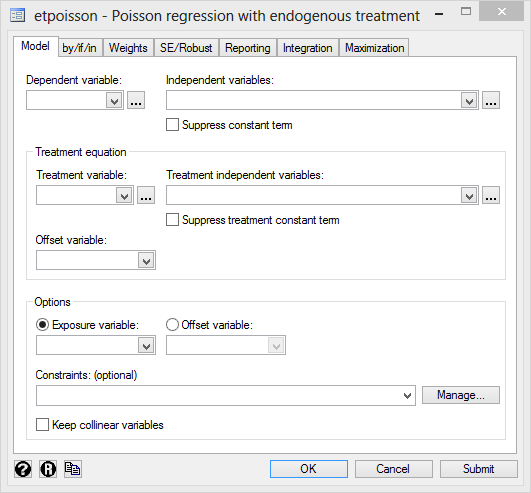
Endogenous treatment effects | Order |

Treatment effects measure the causal effect of a treatment on an outcome. Sometimes, we do not have conditional independence; that is, unobserved variables affecting both treatment and outcome. Endogenous treatment estimators address such cases.
etregress handles continuous outcome variables.
etpoisson handles count outcomes.
Suppose we are studying acne vulgaris in adults. In the data, members of the treated group have a specific genetic marker. That marker is itself determined by covariates, say, x1, x2, and x4. The outcome variable we observe is the number of pimples, and it is determined by x1 and x3. We are also concerned that there are unobserved variables that could cause the presence of the marker and affect the number of pimples.
We fit an endogenous treatment-effects model by typing
. etpoisson pustules x1 x3, treat(marker = x1 x2 x4) Poisson regression with endogenous treatment Number of obs = 1000 (24 quadrature points) Wald chi2(3) = 81.50 Log likelihood = -2297.3045 Prob > chi2 = 0.0000
| Coef. Std. Err. z P>|z| [95% Conf. Interval] | ||
| pustules | ||
| x1 | .0509081 .0442439 1.15 0.250 -.0358084 .1376246 | |
| x3 | .1281427 .0313078 4.09 0.000 .0667806 .1895049 | |
| 1.marker | 1.329508 .1994485 6.67 0.000 .9385965 1.72042 | |
| _cons | -.6982827 .1139443 -6.13 0.000 -.9216094 -.4749559 | |
| marker | ||
| x1 | .2638588 .0469415 5.62 0.000 .1718552 .3558624 | |
| x2 | -.1921751 .048748 -3.94 0.000 -.2877194 -.0966308 | |
| x4 | .4720434 .0465768 10.13 0.000 .3807546 .5633322 | |
| _cons | -.4946407 .1121999 -4.41 0.000 -.7145484 -.2747329 | |
| /athrho | .1350499 .1706788 0.79 0.429 -.1994743 .4695742 | |
| /lnsigma | -.285167 .0516515 -5.52 0.000 -.386402 -.183932 | |
| rho | .1342348 .1676033 -.1968701 .4378552 | |
| sigma | .7518886 .0388361 .6794973 .8319923 | |
The output reveals no evidence of the correlation that would violate conditional independence; the point estimate of the correlation is 0.1342, and the test against 0 is insignificant.
We can obtain the average treatment effect (ATE) based on these estimates by typing
. margins r.marker Contrasts of predictive margins Model VCE : OIM Expression : Potential-outcome mean, predict()
| df chi2 P>chi2 | |||||
| marker | 1 28.30 0.0000 | ||||
| Delta-method | ||
| Contrast Std. Err. [95% Conf. Interval] | ||
| marker | ||
| (1 vs 0) | 2.584824 .485849 1.632577 3.53707 | |
The presence of the marker adds on average 2.58 pustules.
Read much more about endogenous treatment in the manuals at etregress and etpoisson.
See New in Stata 19 to learn about what was added in Stata 19.